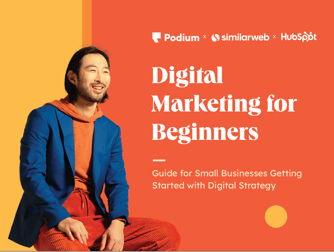-

The Future of SEO: How People Will Get Their Questions Answered in 2+ Years
Get expert insights on how AI, LLMs, and evolving search habits are shaping the future of ...
Zoe Ashbridge
4/28/25
-

How AI Will Impact Advertising, According to Top Marketing Executives [New Data]
Discover how AI is reshaping the advertising industry as professionals navigate its adopti...
Martina Bretous
4/28/25
-

Social Media Marketing Campaigns: What I’d Do to Stand Out on Every Platform [+ ...
Discover the ways you can increase website traffic, drive sales, and build relationships w...
Justina Thompson
4/28/25
-

Global Expansion Misfires and Triumphs: Lessons from Liquid Death & 7-Eleven
Learn why 7-Eleven thrives in Japan while Liquid Death failed in the UK, and discover key ...
Cyan Zhong
4/28/25
From HubSpot's video library
-
.jpg?height=240&name=YT-237_A%20(1).jpg)
How to Start Affiliate Marketing With No Experience or Money (4 Free Tools!)
-

How Airlines Really Make Money | Hustlenomics | The Hustle
-
.jpg?height=240&name=IMG_0735%20(1).jpg)
What Entrepreneurs Can Learn From Native Deodorant
-

Meet the Designer Behind the Iconic Nudie Suit | Unknown Empires
-

Tips For Elevating Your Next Go-To-Market Strategy (+ Free Templates)
-

Why T-Mobile Trademarked This Color | The Hustle
-
.jpg?height=240&name=YT-237_A%20(1).jpg)
How to Start Affiliate Marketing With No Experience or Money (4 Free Tools!)
-

How Airlines Really Make Money | Hustlenomics | The Hustle
-
.jpg?height=240&name=IMG_0735%20(1).jpg)
What Entrepreneurs Can Learn From Native Deodorant
-

Meet the Designer Behind the Iconic Nudie Suit | Unknown Empires
-

Tips For Elevating Your Next Go-To-Market Strategy (+ Free Templates)
-

Why T-Mobile Trademarked This Color | The Hustle
-
.jpg?height=240&name=YT-237_A%20(1).jpg)
How to Start Affiliate Marketing With No Experience or Money (4 Free Tools!)
-

How Airlines Really Make Money | Hustlenomics | The Hustle
-
.jpg?height=240&name=IMG_0735%20(1).jpg)
What Entrepreneurs Can Learn From Native Deodorant
-

Meet the Designer Behind the Iconic Nudie Suit | Unknown Empires
-

Tips For Elevating Your Next Go-To-Market Strategy (+ Free Templates)
-

Why T-Mobile Trademarked This Color | The Hustle
-

10 SaaS Onboarding Best Practices to Ensure Your Customers' Success
Through leading client platform training sessions and demos, I developed 10 key practices ...
Diego Alamir
4/15/25
-

Customer Profiling in 10 Easy Steps [+ Templates]
In this article, I’ll explore customer profiling, explain why it’s important, and provide ...
Diego Alamir
4/14/25
-

22 Customer Touchpoints That Will Optimize Your Customer Journey
Learn everything you need to know about customer touch points, including what they are and...
Clint Fontanella
4/11/25
-

How I Write Effective Knowledge Base Articles [+Templates]
This guide will walk you through everything you need to know to leverage knowledge bases f...
Diego Alamir
4/10/25

An Introduction to Digital Marketing
Learn the basics of digital marketing and explore different ways to reach your ideal customer.
-

5 Qualities Effective Sales Leaders Need to Have, According to Experts
Want to become one of the best reps at your company? Use these 31 highly effective strateg...
Kiran Shahid
4/28/25
-

I Took a Deep Dive Into AI Sales Agents — Here’s What the Landscape Looks Like T...
AI sales agents can turn data you already have into powerful selling strategies. Learn how...
Kolawole Samuel Adebayo
4/28/25
-

Sales Pipelines: A Comprehensive Guide for Sales Leaders and Reps
Understand every stage of the sales pipeline and how to convert leads into deals with this...
Kiara Taylor
4/28/25
-

The Types of Business Structures and How To Choose the Right One
Sole proprietorship, LLC, partnership, or corporation? Learn which business structure fits...
Saphia Lanier
4/24/25
From the HubSpot Podcast Network
-
Business Made Simple

Your Website Probably Stinks—Here’s How to Fix It!
-
The Science of Scaling

How to Scale a Billion Dollar Sales Team w/ John McMahon (Board Member, Snowflake)
-
Truth, Lies and Workplace Culture
-2.png?height=240&name=PodcastCovers23%20(1)-2.png)
From Bystander to Ally: How to Avoid DEIB Washing
-
Imperfect Action
-2.png?height=240&name=PodcastCovers23%20(4)-2.png)
The art of the post-launch review: 5 questions to make your next launch a success
-
Latinx In Power
.png?height=240&name=PodcastCovers23%20(6).png)
Harnessing the Power of Silence in Negotiation with Diana Kleps
-
The Sales Evangelist

5 Ways To Do Daily Outbound With LinkedIn
-
Business Made Simple

Your Website Probably Stinks—Here’s How to Fix It!
-
The Science of Scaling

How to Scale a Billion Dollar Sales Team w/ John McMahon (Board Member, Snowflake)
-
Truth, Lies and Workplace Culture
-2.png?height=240&name=PodcastCovers23%20(1)-2.png)
From Bystander to Ally: How to Avoid DEIB Washing
-
Imperfect Action
-2.png?height=240&name=PodcastCovers23%20(4)-2.png)
The art of the post-launch review: 5 questions to make your next launch a success
-
Latinx In Power
.png?height=240&name=PodcastCovers23%20(6).png)
Harnessing the Power of Silence in Negotiation with Diana Kleps
-
The Sales Evangelist

5 Ways To Do Daily Outbound With LinkedIn
-
Business Made Simple

Your Website Probably Stinks—Here’s How to Fix It!
-
The Science of Scaling

How to Scale a Billion Dollar Sales Team w/ John McMahon (Board Member, Snowflake)
-
Truth, Lies and Workplace Culture
-2.png?height=240&name=PodcastCovers23%20(1)-2.png)
From Bystander to Ally: How to Avoid DEIB Washing
-
Imperfect Action
-2.png?height=240&name=PodcastCovers23%20(4)-2.png)
The art of the post-launch review: 5 questions to make your next launch a success
-
Latinx In Power
.png?height=240&name=PodcastCovers23%20(6).png)
Harnessing the Power of Silence in Negotiation with Diana Kleps
-
The Sales Evangelist

5 Ways To Do Daily Outbound With LinkedIn
-

A Web Accessibility Checklist to Make Your Content 100% Compliant
Learn how to ensure your website is fully accessible with this Web Accessibility Checklist...
Taylor Cromwell
4/24/25
-

How to Add a Parallax Scrolling Effect to Your Website [Examples]
Learn everything you need to know about parallax scrolling, from what it is to how to crea...
Clinton Joy
4/23/25
-

20 Best WYSIWYG HTML Editors for 2025
Discover the best WYSIWYG HTML editors that can speed up how you build and edit your websi...
Maddy Osman
4/22/25
-

UX Content Strategy: Real-Life Examples + Steps to Create Yours
Discover how to create a user-centered content strategy that boosts engagement and convers...
Clint Fontanella
4/17/25
-

16 Website Metrics to Track for Growth in 2025 and Beyond
Discover 16 essential website metrics for growth this year and beyond. Learn how to track ...
Jamie Juviler
4/17/25
-

How to Build A Google Site That Looks Good and Drives Business [+ Templates & Ex...
Follow this Google Sites tutorial to create a free, professional website. Perfect for pers...
Allie Decker
4/16/25
Explore more topics
Ready to brush up on something new? We've got more to read right this way.






.png)
